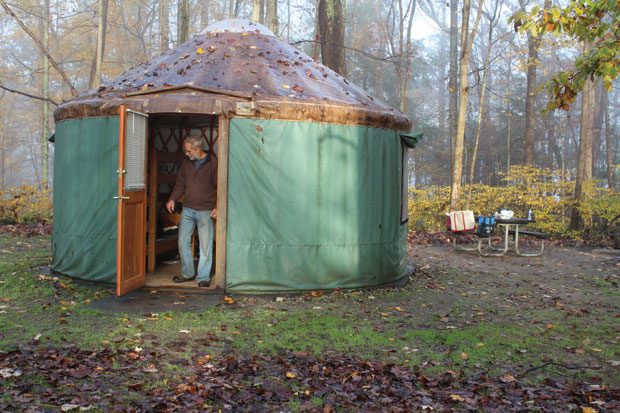
Fog blankets Swarts-wood Lake as we dip our paddles into the glassy water. A family of swans materializes on the surface through the opaque air. Nearby, an osprey dives through the whiteness and resurfaces with a stunned fish. The morning show has begun in Swartswood State Park.
We are following the Water Trail around the 520-acre lake in our canoe. There are 15 charted stops to learn about the rich natural, cultural and historic points of interest. Some of the most interesting sights are uncharted, like the red fox standing motionless on a downed tree.
Swartswood, in the southwest corner of Sussex County, became New Jersey’s first state park in 1914. The lake is a bit older; it was carved by glaciers thousands of years ago. For the past 15 years, overnight visitors to the park have had the opportunity to sleep in yurts.
A yurt is a cross between a cabin and a tent. Traditionally, Mongolian nomads packed these round huts for their desert travels. These days, modern yurts are springing up around the country. Five are available at Swartswood, and they can be found in three other Jersey state parks: Allaire, Belleplain and Byrne. Traditional cabins are also available at Swartswood, as well as sites for trailers, pop-up campers and tents—but a yurt is somewhat unconventional and much more fun.
A wooden lattice creates the frame for the yurt, the roof lines radiating like the spokes of a wheel. Two sets of bunk beds are positioned on either side of the spacious 16-foot-diameter structure. The floor is made of painted concrete. Natural light pours in from the skylight 10 feet above, which is easily opened with a pole for ventilation. Additional ventilation and light are provided through wide screens around the yurt walls,
with vinyl flaps that can be rolled down for warmth.
Swartswood’s five yurts are situated in a loop, with distance between them for privacy and quiet. Parking is a stone’s throw away. The area around our yurt is open and grassy, enabling white tail deer to browse nearby. Through the neighboring forest, the shimmering lake entices us to paddle. It’s a pleasant 10-minute walk to the beach and the marina (where boat rentals are available).
The entire Water Trail can be completed in a leisurely three hours, but we take additional time to get out and hike the 1.5 mile Grist Mill Trail. This loop begins at Keen’s Mill, a restored 1830s mill, on the west end of the three-mile lake.
After our paddle, we hike the 2.8-mile Spring Lake Trail, which winds through a younger forest to secluded Spring Lake. The trail is located in the southeast corner of the park and connects to the 0.6-mile-long Duck Pond Trail, a paved pathway suitable for inline skating, roller blading and wheelchairs; it is accessible from a nearby parking lot.
Back at the yurt, we cook on a fire grate provided by the park. Off in the woods, a great horned owl provides the soundtrack for our repast. Soon, we’ll retire to the yurt to read by lantern light—with little more technology than those desert Mongolians enjoyed.
Cindy Ross blogs about her outdoor adventures at cindyrosstraveler.com.
